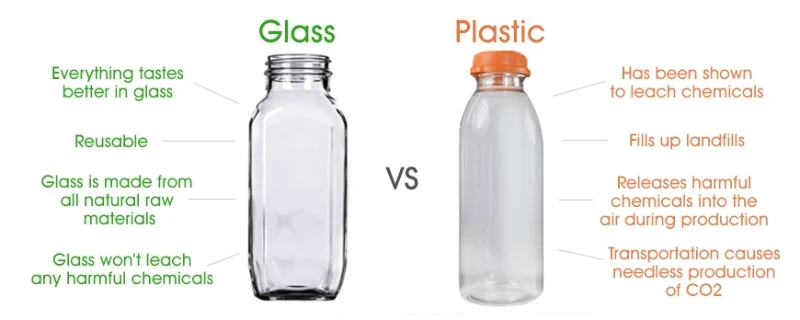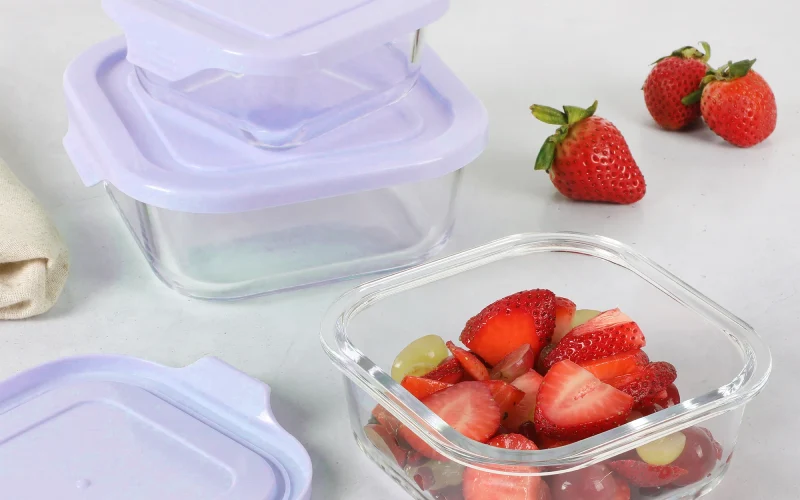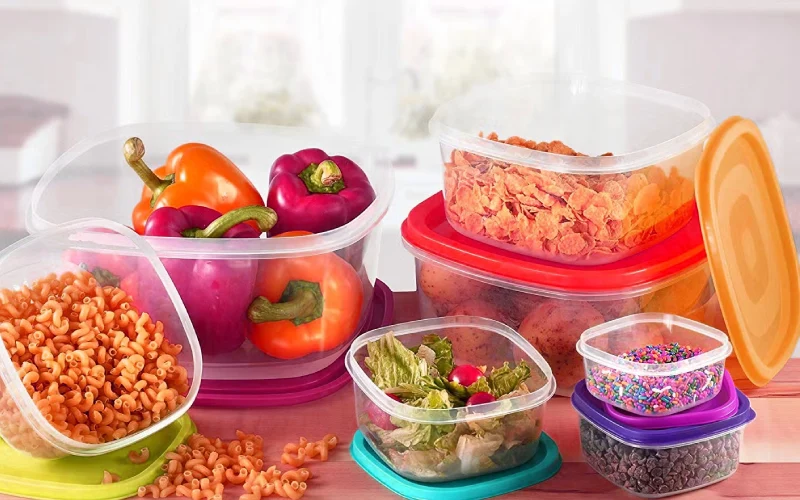When it comes to storing food, choosing the right container is essential for both convenience and safety. In this article, we’ll dive deep into the comparison of glass vs plastic food containers, examining the advantages and disadvantages of both.

Whether you’re looking for a container to store leftovers or meal prep for the week, understanding the pros and cons of each material will help you make an informed choice. Here are seven key differences that will influence your decision!
Food Storage Solutions Choice

BN PACK is a Food Storage Solutions manufacturer from China, with many years of experience in production and sales. Let’s learn together
Food storage is a fundamental part of modern living. Whether you’re organizing your kitchen, preparing meals in advance, or storing leftovers, the containers you use play a significant role in preserving food’s freshness and quality.
Glass and plastic are two of the most common materials used in food storage containers, each offering unique benefits. However, with numerous brands and designs on the market, understanding the key differences between these two materials can help you make the right choice.
What is the Best Glass Food Storage Containers?

Glass food containers have been a kitchen staple for centuries. Unlike plastic, glass is a non-porous material, which makes it ideal for storing food. Its solid, clear appearance also adds a touch of elegance to your kitchen storage. Let’s dive into the key features of glass containers.
The Benefits of Glass Containers
- Non-Toxic & Safe for Food Storage Glass containers are considered one of the safest options for food storage. Since glass is non-porous, it doesn’t absorb odors, colors, or chemicals. This makes it a safer choice for long-term food storage, especially for acidic foods such as tomatoes or citrus.
- Durability Glass containers are generally known for their durability and resistance to wear. They don’t degrade or lose their integrity over time, making them a reliable choice for years.
- Temperature Resistance Glass containers can withstand both high and low temperatures, meaning they can go directly from the refrigerator to the microwave or oven (unless otherwise indicated). This makes them versatile and convenient for reheating or cooking food.
- Eco-Friendly Since glass can be recycled indefinitely without losing quality, it is considered one of the most sustainable options available. If you’re looking to minimize your environmental impact, glass is a great choice.
The Drawbacks of Glass Containers
- Weight One of the major downsides of glass containers is their weight. They are heavier than plastic containers, which can make them less convenient for on-the-go use, especially when carrying several at once.
- Fragility Glass is more likely to break or shatter if dropped, which can make it less suitable for households with young children or for travel. However, many glass containers are now designed with silicone seals to help prevent breakage.
- Cost Glass containers tend to be more expensive than plastic, which could be a consideration if you’re purchasing many containers for bulk food storage.
What is Plastic Food Containers?

Plastic containers are widely popular due to their affordability and versatility. They are typically made from materials such as polypropylene or polyethylene, offering various benefits for food storage.
The Advantages of Plastic Containers
- Lightweight Plastic containers are lightweight and easy to carry, making them a great option for storing snacks, lunches, or meal prep for busy individuals.
- Cost-Effective Plastic containers are much cheaper than glass, which makes them an affordable option for families or those on a budget. They also come in a variety of shapes and sizes, making it easy to find the perfect container for your needs.
- Durability While plastic can crack under certain conditions, many high-quality plastic containers are designed to be flexible and tough. They are less likely to break compared to glass, which is an important factor when considering longevity.
- Versatile Design Options Plastic containers often come in a range of designs, from stackable and compartmentalized to those with built-in locking mechanisms for a tight seal. This makes them ideal for various types of food storage, from snacks to large meals.
The Disadvantages of Plastic Containers
- Potential Chemical Leaching Some lower-quality plastics can leach harmful chemicals into food, especially when exposed to high heat. This is why it’s essential to choose BPA-free and microwave-safe plastic containers.
- Staining and Odor Absorption Plastic containers, over time, may absorb food odors and stains, which can be difficult to remove even with cleaning. This can be especially problematic with foods like curry or tomato sauce.
- Environmental Impact Plastic is less environmentally friendly than glass, as it takes longer to degrade and often ends up in landfills. Although some plastics are recyclable, many are not, contributing to pollution.
Glass vs Plastic Food Containers: 7 Key Differences
| Criteria | Glass | Plastic |
|---|---|---|
| Durability | Highly durable but can break if dropped | Durable, less likely to break, but may crack over time |
| Environmental Impact | Fully recyclable, more eco-friendly | Often non-recyclable, some types recyclable, contributes to pollution |
| Health Implications | Generally safe, no leaching of chemicals | Potential for leaching, especially if not BPA-free or exposed to heat |
| Cost Comparison | More expensive but durable long-term | Cheaper upfront but may need more frequent replacements |
| Aesthetic Appeal | Elegant and clean, transparent for visibility | More utilitarian, available in various colors and designs |
| Storage Efficiency | Heavier, can be bulkier | Lightweight and stackable for efficient storage |
| Long-Term Use and Maintenance | Easy to clean, resistant to staining and odors | Prone to scratches and staining, needs frequent cleaning |
Glass vs Plastic Food Containers Final Choice

Durability and Safety: Glass containers are sturdy and resistant to stains and odors, making them excellent for long-term use. However, they can break if dropped. Conversely, plastic containers are lightweight and less likely to shatter, but they may warp or crack over time. If you frequently transport meals, plastic may be the better option.
Health Concerns: If health is a priority, glass is generally a safer choice as it doesn’t leach chemicals into food. Look for BPA-free plastic containers if you choose plastic to minimize health risks, especially when microwaving.
Environmental Impact: Glass containers are fully recyclable and have a lower environmental impact. They last longer, reducing waste over time. Plastic, while often recyclable, contributes to pollution and may not decompose.
Cost and Aesthetics: Glass containers tend to be more expensive but are a good investment due to their durability. They also offer a more elegant presentation. Plastic containers are cheaper and come in various colors and designs, catering to different aesthetic preferences.
Choosing between glass and plastic food containers depends on your specific needs and preferences. Glass offers durability, safety, and environmental benefits, making it ideal for long-term use. It’s a great option if you prioritize health and sustainability.
On the other hand, plastic is lightweight, cost-effective, and convenient for on-the-go meals, although it may require more frequent replacement. Consider factors such as usage scenarios, budget, and environmental impact to make the best choice for your kitchen and lifestyle.
FAQ
Can I use glass containers in the microwave?
Yes, most glass containers are microwave-safe, but always check for labels to ensure they are designed for microwave use.
Are plastic containers safe for storing food?
Yes, plastic containers are safe as long as they are BPA-free and microwave-safe. Always choose food-grade plastic to avoid harmful chemical exposure.
we prioritize safety in our manufacturing process. All our plastic food storage containers are made from BPA-free materials, ensuring that no harmful chemicals leach into your food.
Do glass containers break easily?
While glass containers are prone to breakage, many are designed with silicone seals or shock-resistant designs to minimize damage.
Which is better for freezing: glass or plastic?
Both materials can be used for freezing, but glass containers should be used with caution, as they can crack if exposed to rapid temperature changes.
Can I customize the containers with my brand logo?
Absolutely! We provide customization options for our food storage containers, including adding your brand logo or specific design elements. Please contact us to discuss your requirements.
Conclusion
Both glass and plastic food containers have their unique advantages. As a supplier of high-quality paper and plastic options, we encourage you to consider the versatility and practicality of our plastic containers for everyday use.
They offer durability and convenience without compromising on safety. For customized solutions that meet your specific needs, don’t hesitate to contact us today. Let us help you find the perfect food storage solutions!
